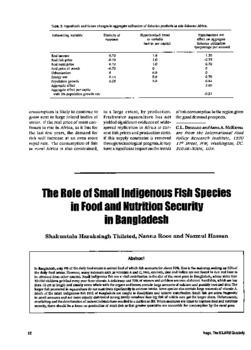The role of small indigenous fish species in food and nutrition security in Bangladesh

Citation
Thilsted, S.H.; Roos, N.; Hassan, N. (1997). The role of small indigenous fish species in food and nutrition security in Bangladesh. NAGA 20 (3/4): 82-84
In Bangladesh, only 6% of the daily food intake is animal food of which fish accounts for 50%. Rice is the mainstay, making up 60% of the daily food intake. However, many nutrients such as vitamins A and C, iron, calcium, zinc and iodine are not found in rice and have to be obtained from other sources. Small indigenous fish are a vital contribution to the diet of the rural poor in Bangladesh, where more than 30,000 children go blind every year from vitamin A deficiency and 70% of women and children are iron-deficient. Small fish, which are less than 10 cm in length and usually eaten whole with the organs and bones, contain large amount of calcium and possibly iron and zinc. The largest fish promoted in aquaculture do not contribute significantly to calcium intake. Some species also contain large amount of vitamin A. Much of the small indigenous fish (SIS) of Bangladesh are caught in floodplains and natural waterbodies. Small fish are eaten frequently in small amounts and are more equally distributed among family members than big fish of which men get the larger share. Unfortunately, overfishing and the deterioration of natural habitats have resulted in a decline in SIS. When measures are taken to improve food and nutrition security, there should be a focus on production of small fish so that greater quantities are accessible for consumption by the rural poor.
Permalink
Date Available
Type
Publisher
Countries
Copyright
CC BY 4.0
Research Themes
Language